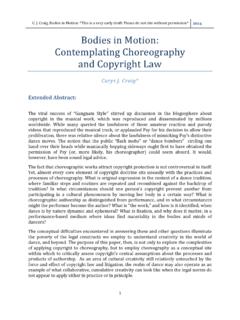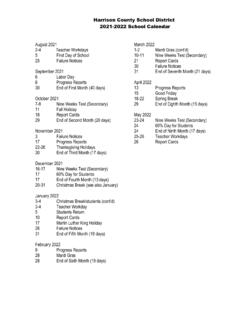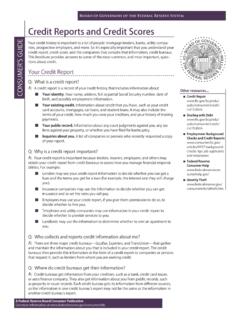Transcription of Police Violence, Use of Force Policies, and Public Health
1 American Journal of Law & Medicine, 43 (2017): 279-295 American Society of Law & Medical Ethics, 2017 The Author(s) Boston University School of Law DOI: Police VIOLENCE, USE OF Force POLICIES, AND Public Health Osagie K. Obasogie & Zachary Newman I. INTRODUCTION Racialized Police violence1 is a recurring Recent social movements have re-centered Police violence as a subject of Public discourse,3 yet there has been little progress in reducing the number of people killed by Without further efforts in research and legal reform, this everyday crisis will continue.
2 Thus, material interventions designed to fundamentally shift Police practices away from deadly engagements are greatly These interventions have the potential to disrupt current policing practices that continue to determine which lives are valued physically and discursively and Osagie K. Obasogie is Haas Distinguished Chair and Professor of Bioethics, University of California, Berkeley. , Yale University; , Columbia Law School; , University of California, Berkeley.
3 Zachary Newman is a Visiting Scholar at the Haas Institute for a Fair and Inclusive Society, University of California, Berkeley. University of California, Santa Cruz; University of California, Hastings College of the Law. 1 We employ the term Police violence, as opposed to Police brutality or another similar term, because we believe this to be a systemic, generalized problem, not one that is individuated and momentary. In addition, by violence, we mean the intentional use of physical Force or power, threatened or actual, against oneself, another person, or against a group or community, that either results in or has a high likelihood of resulting in injury, death, psychological harm, maldevelopment or deprivation.
4 WORLD Health ORGANIZATION [WHO], WORLD REPORT ON VIOLENCE AND Health , at 4 (2002), 2 See, , Nancy Krieger et al., Trends in US Deaths Due to Legal Intervention Among Black and White Men, Age 15-34 Years, by County Income Level: 1960-2010, 3 HARV. PUB. Health REV. 1 (2015). 3 See Alicia Garza, A Herstory of the #BlackLivesMatter Movement, THE FEMINIST WIRE (Oct. 7, 2014), ; see generally JEFF CHANG, WE GON BE ALRIGHT 3 (2016) ( Race makes itself known in crisis, in the singular event that captures a larger pattern of abuse and pain.)
5 We react to crisis with a flurry of words and, sometimes, actions.. The cycle turns next toward exhaustion, complacency, and paralysis. And before long, we find ourselves back in crisis. ). 4 Kimbriell Kelly, Fatal Shootings by Police Remain Relatively Unchanged After Two Years, WASH. POST (Dec. 30, 2016), 5 Nancy Marcus, From Edward to Eric Garner and Beyond: The Importance of Constitutional Limitations on Lethal Use of Force in Police Reform, 12 DUKE J. CONST. L. & PUB. POL Y 53, 106 (2016) ( The collective conscience of this nation has driven a nationwide policing-reform movement to remedy the abuses, excesses, and systemic discriminatory practices in American policing.
6 It can no longer be a common or acceptable practice in this country for Police to gun down or otherwise use deadly Force against unarmed civilians .. ). AMERICAN JOURNAL OF LAW & MEDICINE 280 which can be lost to incessant Police While many strategies for addressing Police violence have been proposed, existing discussions do not fully engage a primary factor in Police violence and major barrier to accountability: use of Force policies. These are the policies that codify the rules that govern the levels and types of Force that Police are permitted to use against citizens, including deadly These rules are important because they are not only used to train Police and guide their engagements with the community.
7 But are also used as benchmarks when evaluating whether their use of Force is This Article examines use of Force policies that often precipitate and absolve Police violence as not only a legal or moral issue, but distinctively as a Public Health issue with widespread Health impacts for individuals and This Public Health framing can disrupt the sterile legal and policy discourse of Police violence in relation to communities of color (where conversations often focus on limited queries such as reasonableness) by drawing attention to the Health impacts of state-sanctioned Police violence.
8 This approach allows us to shift the focus from the individual actions of Police and citizens to a more holistic assessment of how certain policy preferences put Police in the position to not treat certain civilians lives as carefully as they should. In sum, we seek to (1) develop an empirical understanding of the substance of existing use of Force policies and (2) discuss how these policies relate to Police violence in general and Public Health in particular. Not unlike seat belt laws or mandatory vaccinations, we see use of Force policy reform as a site where a Public Health law sensibility can create the conditions for increasing survivability and decreasing adverse Health outcomes by minimizing the likelihood of Police Force use and its severity.
9 Accordingly, our research questions are aimed at understanding how use of Force policies, Police violence, and Public Health intersect. We pursue this by conducting a content analysis of use of Force polices from the twenty largest cities by population. Unlike previous use of Force analyses, this qualitative assessment takes a deep look at the language used to confer and restrain Police power, which provides a basis from which to think through the link between textual articulation, Police practice, and community Health outcomes.
10 This content analysis is then put in conversation with existing literature to explore and hypothesize this link and opportunities for disruption in the name of improving Health outcomes. II. LITERATURE REVIEW This Article attempts to connect literatures on use of Force polices, Police violence, and Public Health in order to note their intersection and to contextualize this research project. We briefly describe these literatures below. 6 See Osagie Obasogie & Zach Newman, Black Lives Matter and Respectability Politics in Local News Accounts of Officer-Involved Civilian Deaths: An Early Empirical Assessment, 2016 WIS.














